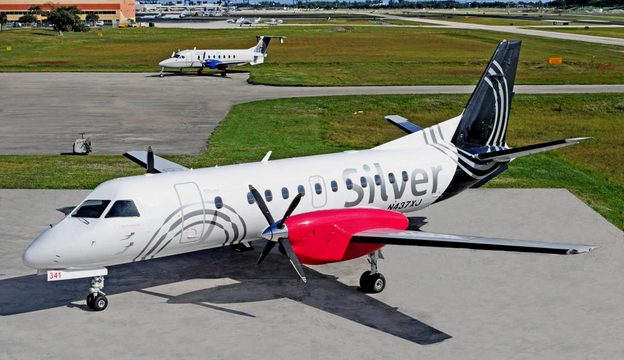Federally subsidized air service strains meaning of ‘essential’

GOVERNMENT PAPER FOR SILVER: Silver Airways receives millions in government subsidies annually.
By Steve Wilson | Mississippi Watchdog
The Essential Air Service program — the federal government program that provides subsidies for commercial air service to smaller communities — strains the definition of essential for much of the country.
In Alaska and some parts of the West, the service fits the definition, as many of these communities have few roads connecting them with the rest of the respective state.
But in more populated parts of the country, federally subsidized air service becomes far less essential. Many of these airports are within 150 miles of a bigger airport. Changes in the way the airlines operate has made this program a politically popular anachronism from the days of the rotary dial phone and mood rings.
“While it may look like that, this really is a program that had good intentions but has lived long past its usefulness,”said Brett Snyder, a former airline marketing expert and analyst who runs the airline blog Crankyflier.com. “Except in few cases, I think it’s a tough argument to make that EAS is a worthwhile investment by the federal government. When the airlines were deregulated in the late 1970s, there was real concern that small airports would lose service, so they created EAS to ensure that all cities retained some level of service.
“But as airlines changed the way they looked at serving airports (more hub and spoke, less train-like lines), the demand for service in the smallest of cities really evaporated. People found it far easier to just drive to the nearest bigger airport.”
The federal government is trying to reform this system. The Department of Transportation has capped the per-passenger subsidy at $200. Rules on the 10-enplanements — a measure of boarding passengers — and an airport’s proximity to a larger facility are enforced on airports receiving EAS subsidies, and airports that can’t comply lose them.
MISSISSIPPI IS A BARGAIN: Compared to some of the other Southeastern states involved in the Essential Air Service program, the four Magnolia State airports are a bargain.
In Mississippi, only Greenville‘s Mid-Delta Airport is in danger under the regulations of losing its subsidy. The other EAS airports in Mississippi are Tupelo, Laurel-Hattiesburg and Meridian. While all of the latter three meet the enplanement requirements, they are all within 175 miles of a larger airport.
Gen. Douglas MacArthur said that “old soldiers never die, they just fade away.” Federal programs, even when they are meant to fade away, never die. The EAS subsidy was developed after airline deregulation in 1978 and is still alive 36 years later. In 2013, the government spent more than $218 million to serve more than 90 communities, down from 117 when the program started.
According to Robert Poole, director of transportation policy at the Reason Foundation, the reason the program is still flying high is political.
“Well, certainly it is driven by rural and small-town members of Congress wanting to increase support in their districts by bringing them better air service,” Poole said. “And it appears that the congressional math works out that there are enough states to win assent in the Senate and enough districts with actual or potential recipients to do likewise in the House.”
While the program is serving fewer cities, the price of the subsides is rising. Hattiesburg-Laurel Regional Airport Executive Director Tom Heanue blames the increase on the smaller number of regional airlines and federal regulations that have cut deeply into the numbers of qualified pilots.
At Hattiesburg, the airport’s lone carrier, Silver, received an annual subsidy of more than $2.9 million to provide 12 weekly trips to Atlanta, up from the $1.3 million that Delta received. In Meridian, Silver received a subsidy of more than $2.4 million to provide Meridian with 13 nonstop round trips per week to Atlanta. Delta’s subsidy was $684,000.
The cheapest of the three proposals to replace Silver at the two airports — which announced it is departing several small airports in Mississippi in April — requires a subsidy of more than $7 million.
“They’ve gone through the roof,” Heanue said of the subsidies. “We went from $1.3 million with Delta to $2.9 million, which is a ludicrous jump. Air carriers don’t call them EAS markets anymore, they call them at-risk markets. When they’re going in there, they’re taking a risk going into that market and supplying service.”
Like “Field of Dreams,” Heanue said that he believes if a service can get established at an airport like his, it can grow, prosper and eventually wean itself off subsidies.
“Our goal is to get out of this high subsidy,” Heanue said. “Once they get established, get their ridership up and start making money, the next time they ask for a subsidy, it won’t be as high. They’ve proven that in other markets, where it’s gone way down. You just want to get off welfare.”
Even with Delta flying into Hattiesburg, that has never happened. The Laurel-Hattiesburg Airport opened in 1974, and it’s been a part of the EAS program since 1979.
Contact Steve Wilson at swilson@watchdog.org
Get regular updates on Mississippi through our Facebook or Twitter accounts







